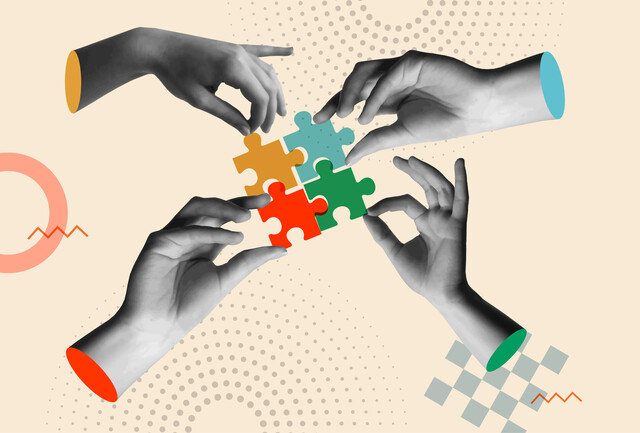Be a Competent Communicator
Communication Competence Defined
In communicating with others, some people are "better" at it than others. Our goal is to provide you with the knowledge and tools to help you improve your own communication with others. The first step to this is understanding that communication can be improved with targeted skills. The first idea along this path is the idea of communication competence. Interpersonal communication researchers have defined this term as "communicating in ways that are effective and appropriate for a given situation." It is important to understand this idea as this is what generally defines a "good" communicator versus a poorer one. We intend to help you improve your communication competence by providing you with knowledge, which will in turn lead to improved relationships and successes. Let us explore this idea more in depth.
To communicate effectively means to get your point across in the way that you intend. The message that you intend to send has been received by your audience in the way in which you have intended it. Misunderstandings do not occur.
To communicate appropriately means to attend to the rules and expectations that apply in a social situation. This component is a bit trickier since appropriate communication varies with the individual with whom you're communicating, and the cultural identities this person holds. We will discuss these cultural memberships more in the next chapter. For now, it is merely important to recognize that what is deemed appropriate, varies with your audience and your specific situation.
Communication Competence Components
Researchers have broken down the characteristics of competent communicators into five (5) areas: self-awareness, adaptability, empathy, cognitive complexity, and ethics. We shall define and discuss each, in turn.
Self-awareness means being aware of your own communication behaviors. Part of this is self-monitoring, which means that you observe your own communication behaviors and ensure they are appropriate to the situation. As an example, if you are someone who tends to use foul language, you would self-monitor while you're in a place of religious worship -- such as a church, temple, or mosque -- and refrain from such language usage in this environment.
Adaptability is the ability to adapt your communication to the environment you're in. That is, you wouldn't communicate in the same way to your closest friends as you would to your co-workers. Rather, while you're at work, you would adapt your communication behaviors to the norms and standards of the communication environment at work, and when you're with your friends, you adapt to that social environment accordingly.
Empathy means that you communicate with another person while putting yourself in that person's shoes, so to speak. For example, if your friend has just announced he is getting a divorce, you would consider that friend's frame of mind and refrain from bringing up how great your own significant relationship is at the moment, aware that such statements will likely only serve to make your friend feel worse about his or her own challenging situation.
Cognitive complexity is the idea that another's communication behavior can have multiple sources. This means that when someone is sharp with you, it could be from something you've done, yes, and perhaps that person is reacting to you. However, it could also be a result of that person's physical well-being at the moment -- perhaps s/he has a headache or didn't get enough sleep the night before -- or something in that person's life that is weighing on him or her at the moment.
Ethics means to communicate in ways that are morally correct. That is, when someone is particularly vulnerable, we don't take advantage of that person's weakened state to get him or her to agree to something that s/he otherwise would not likely have done.
INTERCULTURAL COMMUNICATION
The idea of intercultural communication includes more than merely communication among those of different nationalities, from different countries. It includes that, yes, but as we will see in a moment, this idea includes a much more in-depth definition.
Culture Defined
Before we can discuss intercultural communication, we need a working definition of culture, so that we are all talking about the same thing. There are several definitions of culture available. The one we will use here is, "learned, shared symbols, language, values, and norms that distinguish groups of people." Let us discuss each of these components in turn.
First, this system of symbols, language, values and norms is learned by the members of the culture, and shared by the members of the culture. None of these components has inherent meaning; rather, meaning is assigned by the members of the culture and taught to other members of the culture. This sharing of learned symbols, language, values, and norms defines a culture, and distinguishes it from other cultures.
Symbols are things that represent ideas. Symbols can be words or nonverbal items. For example, a vertical line that is crossed about one-third of the way down, with a shorter horizontal line, forms a type of cross that has come to represent Christian belief. As another example, the color red is considered good luck in China. There are numerous symbols in each culture, and the same symbol has different meaning in different cultures. For example, making a fist with the thumb sticking up vertically means "good job," or "A-okay," in some cultures, while it has a very offensive connotation in other cultures.
Language is a bit more complex than it may appear at first glance. Researchers estimate there are approximately 6,800 different languages in the world. This is the distinction most people consider when thinking of language. When we talk about culture, we are definitely talking about those national languages -- but we are also talking about something more. Different groups of people use language differently. Consider the slang terms and jargon used by people of different ages, regions, professional fields, and other social groups. For example, in the American South, it's common to hear that people are "fixin" to do something, though that term is not widely used outside of the South. A young person in the U.S. is "sicks" if he is "cool," but for those of us a bit older, "sick" is not something positive. Consider how lost you often feel when two friends from a field that is not your own have a conversation about their work; it almost seems as if they are speaking a foreign language. The same is true for serious athletes -- their "lingo" is neither widely shared, nor widely understood by outsiders. In these examples, language defines a social group, and distinguishes one social group from another.
Values are standards that people of a culture use to decide whether something is "good" or "bad." For example, Americans value individualism -- the idea that the needs of the individual come before the needs of any group, while many cultures prize collectivism -- the idea that needs of the group outweigh the needs of the individual. Different religious groups prioritize different values. In some religions, extramarital sexual relations is strictly forbidden, while the same behavior is perfectly acceptable by value systems of other religions. When we consider U.S. political affiliations -- and the infamous gridlock on Capitol Hill -- we can perhaps more clearly see that different groups of people hold different values. In this example, Democrats and Republicans as general groups assert very different positions, and within those two major affiliations, numerous factions argue among themselves over what is right and wrong for society. In these ways and countless others, different groups of people hold different values.
Norms are rules or expectations that guide people's behavior. Festival and religious celebrations fall under this category, as do traditions. Each culture has its own guidelines for celebrating a couple's union and honoring the dead, for example. On a smaller scale, certain unspoken dress codes apply within social groups--you probably wouldn't wear a bathing suit to a night club (unless you're in a beach town where that is the norm). Similarly, you probably wouldn't yell loudly during a religious ceremony while the leader is speaking; such behavior would be considered extremely inappropriate. However, the same behavior is perfectly acceptable in a comedy club. Norms are all around us, and have become such an entrenched part of our daily lives, that we don't usually even realize we're complying with them. But if we don't, we know there will be social repercussions. An outsider is often marked by his or her violations of a group's norms.
A culture is defined and represented by the symbols, language, values, and norms that are learned and shared by all members of a social group. Differences in use and interpretation of symbols, language, values, and norms distinguish one culture from another.
Co-culture
The idea of co-culture is alluded to in the above definitions, and means smaller cultural units within larger cultural groups. When we consider the variations in meaning and use of symbols, language, values, and norms among groups of people such as men and women, ethnicities (e.g. Italian-American culture), religious groups (e.g. Hindu culture), political groups (e.g. conservative culture), people of different ages (e.g. youth culture), people of different sexual orientations and identities (e.g. transgender culture), different professions (e.g. the legal field), different athletic involvements (e.g. hockey culture), and different regions -- even from one side of town to the other -- we are talking about co-cultures. We each belong to numerous co-cultures. This is an important idea, as our co-culture memberships help shape our values, attitudes and beliefs -- and our interpretations of others' communications, as we will see in a moment.
Perceptual Filters
Each of us has a unique set of experiences in the world. These are things we've seen and been exposed to, and the ways in which we've been treated at certain times. The idea of perceptual filters suggests that each experience forms a type of filter through which we interpret our worlds. When we witness an event, or receive some communication, we process it through our own unique sets of perceptual filters to discern meaning. Because sets of perceptual filters are unique to each individual, each person will process an event or communication slightly differently. This helps explain why different people have different versions of the same event, such as a car accident they've witnessed or a story someone else has told. This also helps explain different interpretations of a singular message.
Co-culture memberships each offer a set of perceptual filters through which we interpret our worlds and the communications of others. An ex-convict may perceive the close proximity of another person as a severe threat, while a collegiate wrestler may not think anything of it, even if both individuals are the same gender, race, age, region, religion, and socioeconomic background. Different sets of perceptual filters help explain different interpretations of the same communication behavior--and misinterpretations and misunderstandings among individuals.
Triangle of meaning
The triangle of meaning also helps explain how different people have different interpretations of the same communication behavior. It works like this:
Imagine a triangle. At one point of the triangle is the symbol used to represent something, such as a word. At the second point of the triangle is the idea in your mind that this symbol represents. The third point of the triangle represents the actual thing being represented by the word. See the diagram below.
Figure 2.1: Triangle of meaning
The triangle of meaning helps explain misunderstandings and misinterpretations, because we each may have slightly different interpretations of a symbol, based in part on our unique sets of perceptual filters. For example, you and your friend are cooking together and she asks you to hand her "the knife." Happy to oblige, you hand her the 10" chef's knife in front of you. However, your friend wants to peel the apple in her hand, rather than slice it, and she wanted the paring knife. You don't usually peel your apples - or use a paring knife at all, for that matter -- so your set of perceptual filters doesn't consider this possibility when your friend asks you for the knife. You do, however, often slice apples and you use a chef's knife to do so, so this filter does exist in your set of perceptual filters. Therefore, you handed your friend the chef's knife. This misunderstanding is not likely a big deal and your friend will probably simply say, "No, I meant the paring knife," which you then hand her, and that is the end of it.
These types of misunderstandings can lead to arguments, however, when one person expects the other person to understand exactly what is intended, and the one receiving the communication understands it differently -- based on his or her own set of perceptual filters. The idea of the triangle of meaning can help assuage tensions in misunderstandings, if we keep in mind that each of us possesses our own set of perceptual filters, and it is through this unique set of filters that we interpret our worlds, and the communications of others.
























